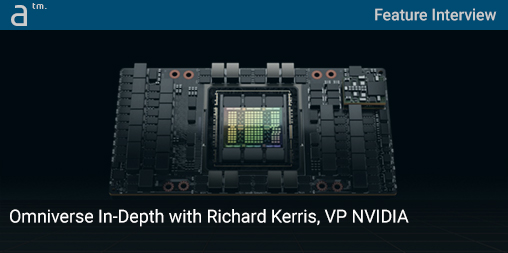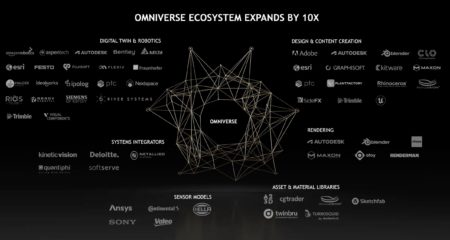NVIDIA AND OMNIVERSE HAVE SO MUCH POTENTIAL TO CHANGE OUR LIVES, and I wanted to know a little bit more about how it all works and the problems it is helping to solve at GTC 2022. I want to ask questions that everyday end users ask when considering these technologies. These questions are the beginning of a much larger conversation, but I hope this will help start it.
The Hero Image
A word about the hero image above. It is a picture of the new NVIDIA H100 GPU, the successor GPU architecture to NVIDIA Ampere. Named after Grace Hopper, a pioneering US computer scientist, the new architecture delivers an order of magnitude of power over the Ampere architecture. Exciting things will be powered by the Hopper architecture, including complex digital twins (think large buildings, smart cities, and much more). Grace Hopper’s name is also used for the new ARM Neoverse-based Grace CPU and the NVIDIA Grace CPU Superchip, which combines two Grace CPUs.
These new silicon wonders will help power high-performance compute and AI workloads complimentary to NVIDIA Omniverse. Architosh will be writing about these new chips in its next Xpresso No 37 newsletter coming up soon. (sign-up here!).
Let’s now talk about Omniverse with Richard Kerris.
Richard Kerris Interview
(Akiko Ashley) Will NVIDIA use their technologies to help Climate Change to find solutions for the heat generated by their Data Centers into a renewable form of energy rather than just dissipating the heat with fans? Is it possible for AI to come up with a better solution?
(Richard Kerris) NVIDIA accelerated computing can meet data center demands at lower energy consumption than traditional methods, and NV powers 23 of the world’s 25 greenest supercomputers.
Our end-to-end AI supercomputing platform powered by NV Ampere architecture A100 GPUs is up to 40x more energy efficient than traditional CPU servers when running AI and HPC workloads. A hyperscale data center with NV GPUs and TensorRT takes up 1/47th the rack space of CPU-based systems that it replaces and runs at 95% less energy cost while running all AI models.
If all CPU servers running AI and HPC transitioned to GPUs, the world would save 11 TWh of electricity/yr, equal to two coal-fired power plants or 1.7m cars. We’re also committed to powering our own data center operations with more renewable energy. In FY21, 17 of our data centers were fully powered by renewable energy. Our goal is to match 100 percent of our global electricity use from sources like solar by 2025.
Q: In the world of Omniverse, USD will become what HTML is to the internet, how will end users who connect to Omniverse navigate through different worlds, will users have a standardized profile that has the software licenses of companies like Autodesk or Adobe, and automatically know if the user is a licensed user? How will Omniverse protect proprietary projects? How will it know which projects are for universal use and which are not? Will there be a standard set so users can connect in the same way? How do I go from work projects to playing Fortnite in Omniverse and then switch to Minecraft seamlessly?
At the very core of Omniverse is our base on Universal Scene Description (USD) originally developed by Pixar, but is now adopted across most industries. We think that USD can be thought of like HTML, which enabled the Internet to get to what we know today. HTML helped facilitate every experience on every website from every browser, every device was consistent, and we believe USD will help do the same thing for virtual worlds.
If all CPU servers running AI and HPC transitioned to GPUs, the world would save 11 TWh of electricity/yr, equal to two coal-fired power plants or 1.7m cars.
We need that same kind of plumbing so that every virtual world, no matter what kind of virtual world you’re going to, has a consistency of your experience. We believe, as do many other companies, that USD will be the core of that. The analogy is the HTML of these virtual worlds.
Omniverse is a platform that connects existing workflows and existing tools. The tools that you use don’t have to change with Omniverse, they get enhanced and extended by the platform.
MORE: Universal Scene Description (USD) File Support in Preview App on Mac Monterey
We are actively evangelizing USD support across all developer ecosystems—game development, design and content creation, AEC, manufacturing/industrial, and even robotics, and are seeing a lot of traction and commitment for support.
Q: How will copyrights, trademarks, data privacy, and proprietary data be dealt with within Omniverse?
Omniverse is not a place, it is a technology development platform for developers, enterprises to build and operate their own virtual worlds, and artists to connect their existing 3D tools.
At NVIDIA, we take individual privacy very seriously and scrupulously comply with privacy principles across all our products.
Q: Will the role of CAD and Architectural Design expand in the Omniverse as builders of worlds?
Architecture, engineering, construction, and operations (AEC/O) is one of the primary industries that can benefit from Omniverse, whether design teams connecting their existing 3D workflows with the collaboration aspects of the platform or operating future digital twins of buildings or cities in Omniverse running on NVIDIA OVX.
Q: What kind of government regulation will be some of the obstacles for Omniverse? For example, “Do Not Share My Data” laws in California.
Any new regulation must be considered carefully in the context of the legal framework that already exists. NVIDIA abides by legal systems in the U.S. and Europe which provide a comprehensive framework that applies to all conduct.
Closing Notes
Architosh will have additional articles on GTC22 announcements, including features oriented at industrial applications for digital twins for AEC/O across architecture and infrastructure. So stay tuned at Architosh and join our Xpresso monthly newsletter to never miss a beat on our top stories, learn about emerging technologies (emTech) in CAD industries, plus gain early access to critical feature articles.
About Richard Kerris
Richard Kerris is the VP of Omniverse Development Platform at NVIDIA. He is a member of the board of advisors for OTOY, and in the past held positions as principal, new product development at Amazon AWS, CMO at Avegant, Chief Technology Officer (CTO) at Lucas Film, and Senior Director at Apple. Richard has a deep history in the professional 3D software market with manager and director roles prior to Apple with Alias|Wavefront, Electric Image, Pixar, and Silicon Graphics (SGI).





Reader Comments
Comments for this story are closed